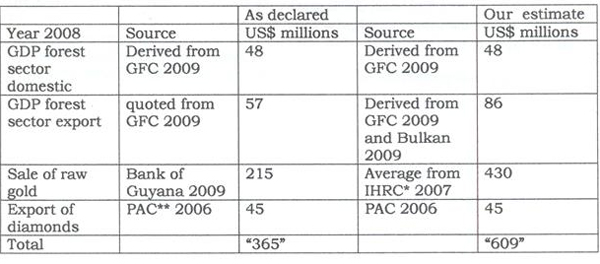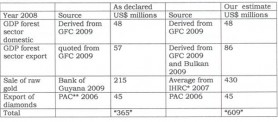Tuesday’s Economic Corner
By Peter R. Ramsaroop, MBA
Introduction:
On July 21, 2009, I wrote a column titled, “Low Carbon-Measuring the Economic Impact”, where I concluded that Guyana needs to retool its LCDS to fit with a national consensus on a national strategy developed with the involvement of all stakeholders, and incorporating additional input such as the Guyana 21 framework. In this way Guyanese would make a real contribution to reducing global carbon emissions rather than just serving as a tool for third party symbolism on global warming.
After this last week in the United States, what has the President brought back in his bag labelled Low Carbon Development Strategy? Nothing, but then neither has any of the other Presidents of salubrious countries who have shared President Jagdeo’s platforms – such as Cameroon, Congo, Papua New Guinea, Tanzania. That is partly because the emitters of forest carbon are not saying clearly how much forest carbon they are willing to reduce when the trading price of carbon is US$X [unknown or undeclared amount] per carbon emissions reduction (CER) unit. Janette Bulkan in her series of ten columns on “Carbon in the forests of Guyana” in Stabroek News during July-August estimated that we have a maximum of 11.4 million tonnes of carbon emissions from our forests annually, based mainly on data from the Guyana Forestry Commission and Tropenbos. The medium-risk price of a CER unit (one tonne of carbon dioxide) on the European Trading Scheme for carbon is about Euros 8, or US$42 per tonne of carbon. So if we were to close down absolutely all the logging and mining and agriculture which are emitting those 11.4 million tonnes, then we could be selling US$479 million worth of forest carbon.
Unemployment:
We already have one of the highest unemployment in the region. With the implementation of LCDS, we would be throwing out of work 27,000 forest workers, log truckers and sawmill operatives, lumber yard suppliers, furniture manufacturers, belna crafters and builders of wooden houses. We would also be displacing 30,000 Brazilian miners and 43,000 Guyanese miners. 271 licensed dredges would be stopped and the 9,000 unlicensed dredges estimated by the Guyana Gold and Diamond Miners Association would no longer be tolerated by the GGMC.
It is curious that in all the sound and fury of the President’s promotion of his Low Carbon Development Scheme these sorts of calculation are never mentioned. Does President Jagdeo think that making unemployed one quarter of the entire population of working age is simply “collateral damage”?
Anyway, by some magic which he has not yet explained, President Jagdeo is telling miners and loggers that they can continue to emit forest carbon – his “business more or less as usual” scenario – while the money rolls in from donors for keeping the forest unmined and unlogged. Perhaps the Norwegians and other prospective donors have appreciated that the stories do not match which may explain why the President is so edgy in his comments on the reluctance of donors to hand over cash to his brand new ‘Guyana Low-Carbon Finance Authority’ housed in the Office of the President (Kaieteur News news item, Sunday 14 June 2009. http://www.kaieteurnews.com/2009/06/14/three-new-institutional-capabilities-to-be-established/ Three new institutional capabilities to be established).
Facts about our Forest:
So how much is Guyana actually getting from the mining and logging in the forests which the President persists in claiming is pristine? – “pristine” means “in its original state”, which is hardly the description of a logged or mined forest. The following table is revealing.
The quotation marks in the last line of the table indicate that we understand well that one cannot add sale prices to GDP estimates, but we have no estimate of the contribution of gold mining and diamond exports to GDP.
*IHRC – International Human Rights Clinic of the Harvard Law School’s Human Rights Program.
**PAC – Partnership Africa Canada – the diamonds and human security project.
These two substantially different figures for the values of the forest and mining sectors in 2008 (US$ 365 million as reported by government agencies and US$ 609 taking account of probable under-declarations and smuggling) contrast with a generous estimate of US$ 479 million from REDD if all deforestation and forest degradation due to mining, agriculture and logging were to be stopped.
Conclusion:
Given this spread, it is not surprising that the President is hedging his bets by repeated assurance that mining and logging will continue as now (more or less, depending on which reported Presidential or Ministerial statement is quoted) while Guyana also receives income from donors for Reduced Emissions from Deforestation and forest Degradation (REDD). Provision of REDD funding in the absence of actions to ensure proper collection and declaration of these other sources of revenue from exploitation of natural resources would, in effect, be a subsidy for continued poor governance.
Compared with the fantastical and not-credible scenario of the President’s LCDS, we now have some more realistic figures to work on. What we in the AFC propose is a full non-partisan (that is, non political) multi-stakeholder revision of the abandoned National Development Strategy, the incorporation of the National Competitiveness Strategy from 2006 (also still-born), Guyana 21 Plan and some of the less fantastic climate adaptation proposals from the LCDS, all worked up into a realistic action plan. (Note, estimates supplied by Dr Janette Bulkan, Colby College, USA]
Until next time “Roop” Send comments to peter.ramsaroop@gmail.com


